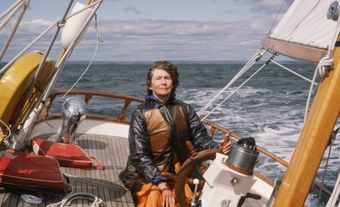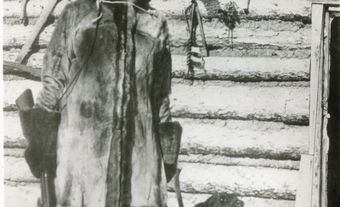Edith Sarah Watson, photographer, painter (born 5 November 1861 in East Windsor Hill, Connecticut; died 22 December 1943 in St. Petersburg, Florida). Edith Watson was a freelance professional photographer who travelled extensively through Newfoundland, coastal Labrador and Canada for about 40 years. She took thousands of photos of the people and places she visited, with a particular focus on working-class women in rural communities. Her photos provide valuable insight into the daily lives of these communities. She spent the latter half of her life travelling and working with her partner, journalist Victoria “Queenie” Hayward. The couple published their work in magazines, newspapers and a book, Romantic Canada.

Early Life and Painting Career
Edith Sarah Watson was born in East Windsor Hill, Connecticut on 5 November 1861. She was the youngest of four children born to Reed and Sarah Watson, a well-established New England family. She grew up surrounded by intellectuals, artists and literary figures with connections to her family. She was educated at home by her mother and attended Hartford Female Seminary, one of the first educational institutions for girls and women in the United States.
After graduating in 1882, Watson and her older sister Amelia spent a few years painting and selling their works throughout New England. They travelled to a different city every few days, transporting their paintings in crates by bus in order to showcase and sell their work.

Solo Travel
In 1891 or 1892, Edith Watson took her first trip to Newfoundland. So began a deep attachment to the region, as Watson returned often throughout the rest of her life. During her first few trips, Watson was known locally as a watercolourist. But when she returned in 1894 with a camera in hand, she soon became known, as one newspaper reported, as “Miss Edith Watson, the well-known camera artist.”
Watson spent most of her time in outports and along the coastline in both Newfoundland and Labrador. She stayed with friends or boarded with families. By the early 20th century, her travels had taken her further inland, to Quebec, Nova Scotia, Ontario and Manitoba. By about 1920, she had reached the West Coast. But Newfoundland and Labrador was always a returning point for her.

Photography
Throughout her travels in Newfoundland and Labrador and Canada, Edith Watson took extensive photographs. While she was a skilled landscape photographer, the bulk of her photos focused on daily life in rural communities. These photos are a considerable primary source of what life was like for the people in these places. While she photographed men and children, she had a particular interest in capturing women. Rather than the stiff, formal portraits of women that were common at the time, Watson’s photos captured women in action. Her photographs show women at their work: carrying pails of water, drying fish or tending the land. She was patient in her work, waiting days if necessary to capture the right shot. She used a soft focus, as was common in the romantic photography popular at the time, but was early to leverage angles and asymmetry in her compositions.
Travel photography became increasingly popular at the turn of the century, providing opportunities for Watson to sell her work. At that time, women accounted for around 15 per cent of professional photographers in both Canada and the United States. She sold her photographs to educational publishers, newspapers and magazines, including the New York Times, Toronto Star, Maclean’s, Saturday Night, National Geographic and The Canadian Magazine. Watson only worked with publications that paid for her photos and was adamant on being credited for her work in print, unusual for photographers at the time. She also exchanged her photographs with transportation companies for railroad passes and steamship tickets, with camera manufacturers for chemicals and photo paper, and with residents for lodging during her travels. During her lifetime, Watson’s photographs were exhibited at the Boston Art Club and the Panama-Pacific Exposition in San Francisco.

Partnership with Victoria “Queenie” Hayward
Beginning in 1898, Edith Watson spent part of the winter in Bermuda, painting and selling small watercolours. It was there in 1911 where friends introduced her to Victoria “Queenie” Hayward, a Bermuda-born journalist. The two formed a connection and the following year, Hayward joined Watson on her travels. As well as being in a romantic relationship, the couple also worked together: Watson supplied the photographs and Hayward provided the text. They travelled extensively through Newfoundland and Labrador, Canada and along the East Coast of the United States. In their travels, they had a particular interest in visiting and documenting rural communities and minority groups. Some of the groups they stayed with included Mennonite and Doukhobor communities in the Prairies, the Haida in British Columbia, and fishing villages in Cape Breton.
In 1920, Watson and Hayward began work on Romantic Canada, a travelogue of places they had been to together. The 250-page book featured over 75 of Watson’s photographs. In the book, Hayward is believed to be the first author to use the term mosaic in reference to the diversity of cultures found in Canada. The term was built upon by other authors in the mid-20th century, who used “Canadian mosaic” or “cultural mosaic” as a way of referencing Canada's multiculturalism. While the book was highly anticipated, delays in printing meant that it was published only a few days before Christmas in 1922, hampering its sales.
The couple remained together until Watson’s death in 1943. She is buried near Wild Acres, her childhood home in Connecticut.

 Share on Facebook
Share on Facebook Share on X
Share on X Share by Email
Share by Email Share on Google Classroom
Share on Google Classroom


